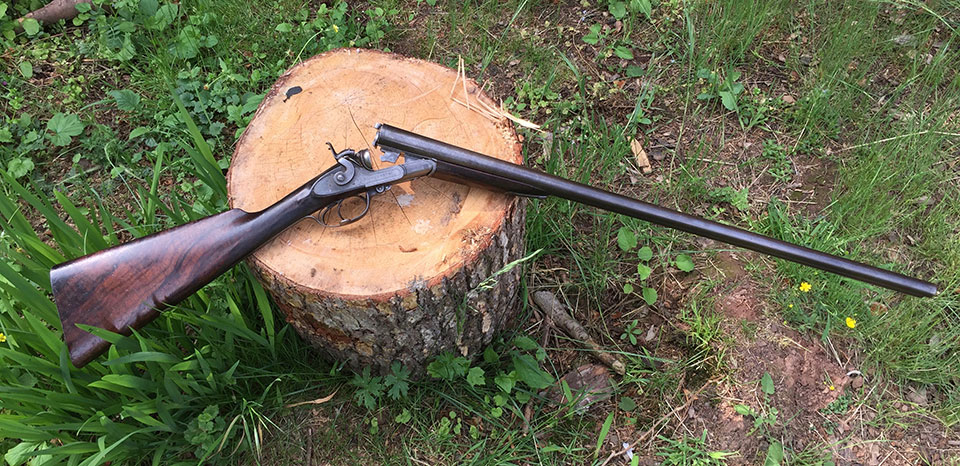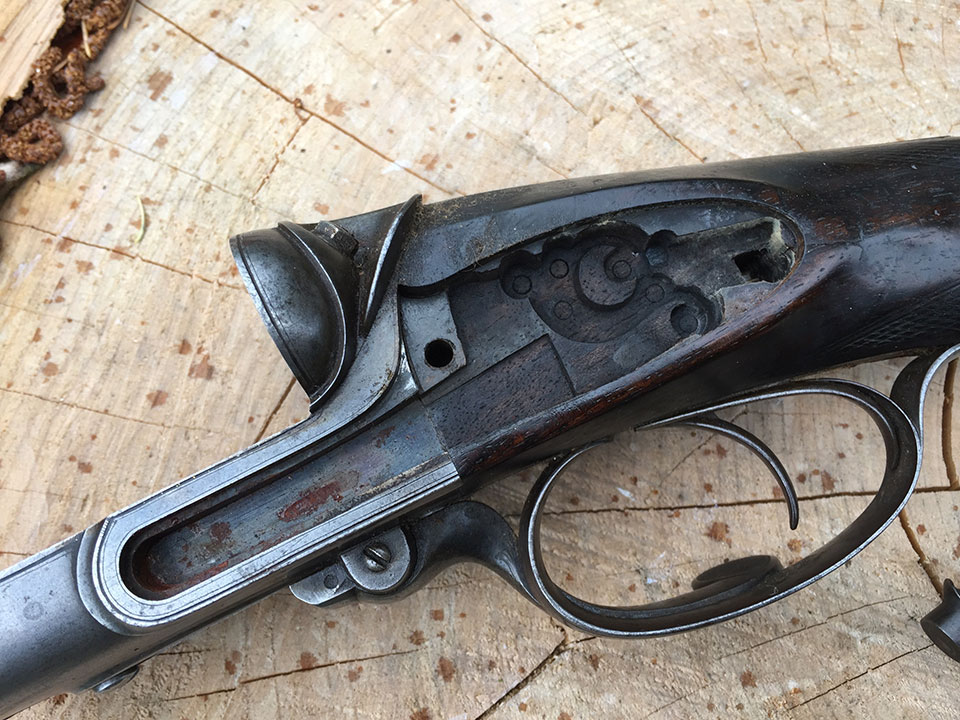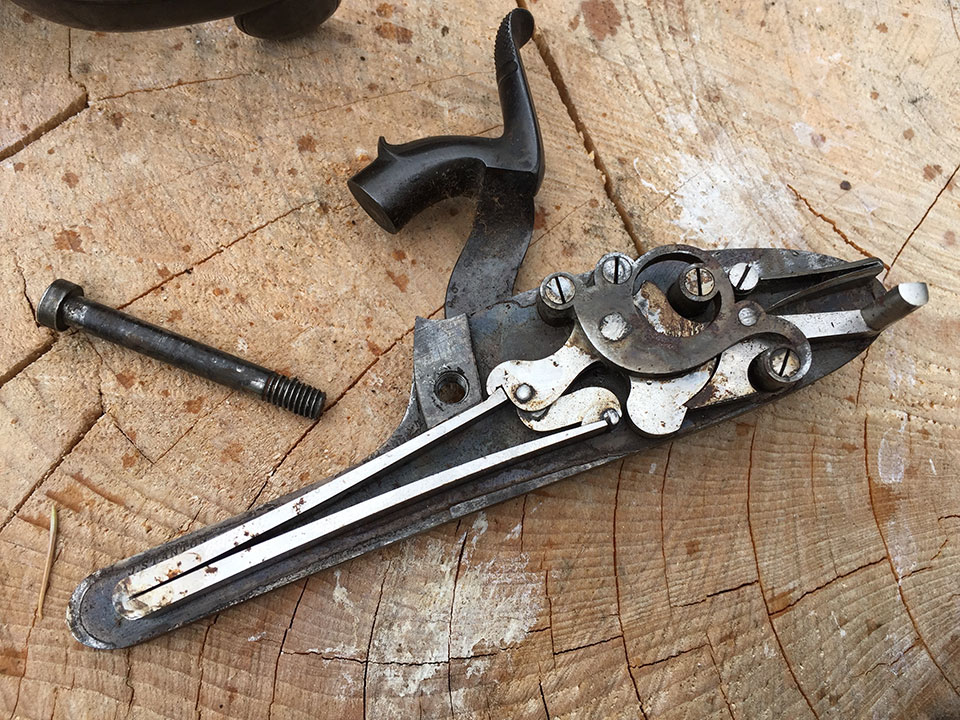Finding decent and interesting hammer guns to restore is a tough task these-days. So, when one turns up, I try to make it work one way or another. However, if you don’t buy the gun in at the right money, you can find yourself hamstrung with a gun you will struggle to get out of with any kind of a profit. On these occasions, if you can’t make the job work, you just have to be hard-headed and walk away.
At first glance, the old Rigby would have looked, to most people, like nothing very special. It was, indeed, very dirty and plain. The chequer was all worn away on hand and forend, the barrels were black and rough and it had hardly any engraving. To me, however, it was more alluring than it would be to the casual observer. The gothic script on the rib read “John Rigby, Dublin & London” and the locks carried the Rigby name, as well. Opening was effected by pushing the slightly protruding tab on the slim under-lever, which followed the contours of the trigger guard. This acted in the manner of a Daw lever, to open and close as a snap action.
The action, though plain was of excellent quality, with rebounding bar -locks and, though dirty, had not been polished or allowed to go rusty during its life. Internally, the locks were clean and crisp, showing remarkably little sign of having been encased in a piece of wood for over a century.
I mentioned the action was plain, but the shapes were elegant and the fit of one metal part into another was very well executed (look at the way the trigger plate fits into the action when you pick up a gun, that is often a good indicator of how much time and what level of quality has been put into it). There were also little indicators that this was not just another plain wild-fowling piece. The lock pin, for example, had a very carefully engraved Tudor style rose on the small end, for example. Pins and screw slots were undamaged and aligned correctly, suggesting the gun had rarely, if ever, been stripped.
Though dirty and worn, the straight-hand stock showed it would have a very nice level of figure and colour, if cleaned up. Th wear was ‘honest’, there were no signs of it having been re-finished and, while used, the gun had not been abused or overly neglected during its lifetime. Age was easy to establish by way of Rigby’s order books. The gun was made in 1875, around a decade after John Rigby III opened his London shop.
As to what the gun was made for, we can observe that it tips the scales at 8lbs 12oz, has 30” barrels with a concave rib and has a feeling of being very robust yet, in the hands, not unwieldy or club-like. The set of the stock and the finish of the gun suggested a quality wild-fowling piece, rather than a live pigeon gun.
The barrels were blacked but they were Damascus. Unfortunately, they were out of proof; the bores being enlarged two or three thou’ over the limit of ten thou’ above the last proof stamp. On the bright side, they measured 36 thou’ minimum, even allowing for a few pits. The right tube was a little bulged, they appeared slightly bent and there were numerous dents and pits, the ribs and loop probably needed stripping. These barrel issues were going to be the expensive ones.
To put the gun back into service would require a lot of barrel work and submission for re-proof. This is always a risk. The chambers looked long and if it transpires that we need to re-proof for 3”, (76mm) the proof houses now often insist that the higher proof test for that chambering be applied, it would also involve re-cutting the chambers to meet the latest C.I.P dimensions.
On the cosmetic side, I was confident that we could bring the gun up to standard, the mechanics were in good order. It did need re-jointing, which is typical for a gun like this and not a problem. While the chequer and drop points would need some skilled attention, they were do-able and the important areas of wood-to-metal fit around the locks, top strap and forend iron all looked very tight and clean.
My conundrum was now apparent. Faced with an 1875 John Rigby wild-fowling piece of good quality, with 30” barrels, long chambers, heavy weight and solid proportion, a very desirable gun. Yet, the amount of work required involved the lottery of submitting it to re-proof, after carrying out some very extensive and expensive barrel restoration. If it failed, the cost would be irretrievable. The overall expense of a careful restoration, if re-proof was successful, was going to approach £1,500. Fully restored, my estimate of re-sale value was £2,800 – £3,000.
To make it worth the time, money and risk, the gun would need to be bought in at £500. Unfortunately, the asking price was £1,350. Much as I liked the gun, I just could not see a way of making the project work with these figures.
Had I the luxury of an unlimited budget, my instincts were urging me to restore the gun. It had the potential to be something quite special. I would appreciate it, though not everyone would see the quality past the, apparently plain, action. It was, therefore, with something of a heavy heart that I packed the Rigby back into the wooden box in which it had arrived from Ireland, where it had spent it’s working life, and sent it back to the chap who had offered it to me.
This was a case of head ruling heart. I shall think about this Rigby often, I expect. There should have been a way of making it viable but, if you start with a number that is too high, you can quickly find a project runs-up a tab that the resale price will not cover. I hope somebody finds the Rigby who likes it enough to finance a proper restoration and, as end-user, is not so worried about the final cost. As a commercial proposition, this one just didn’t work for me.
Published by Vintage Guns Ltd on (modified )



